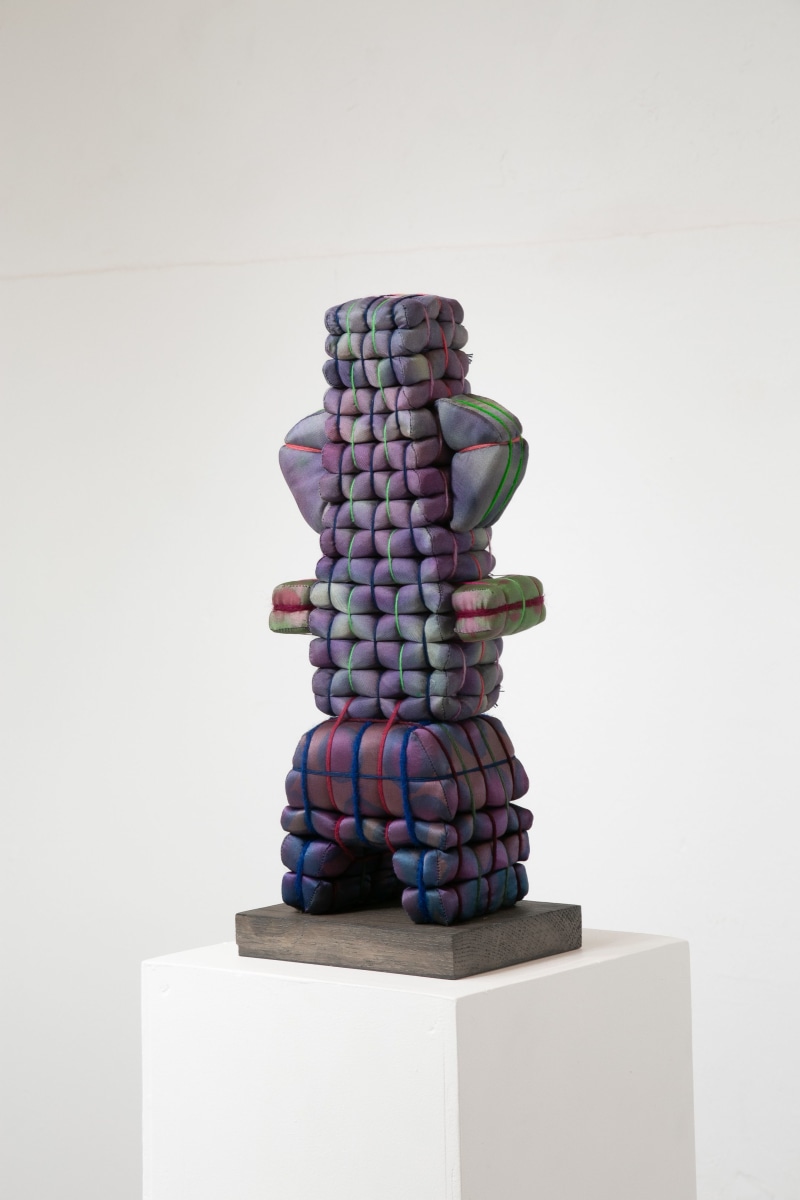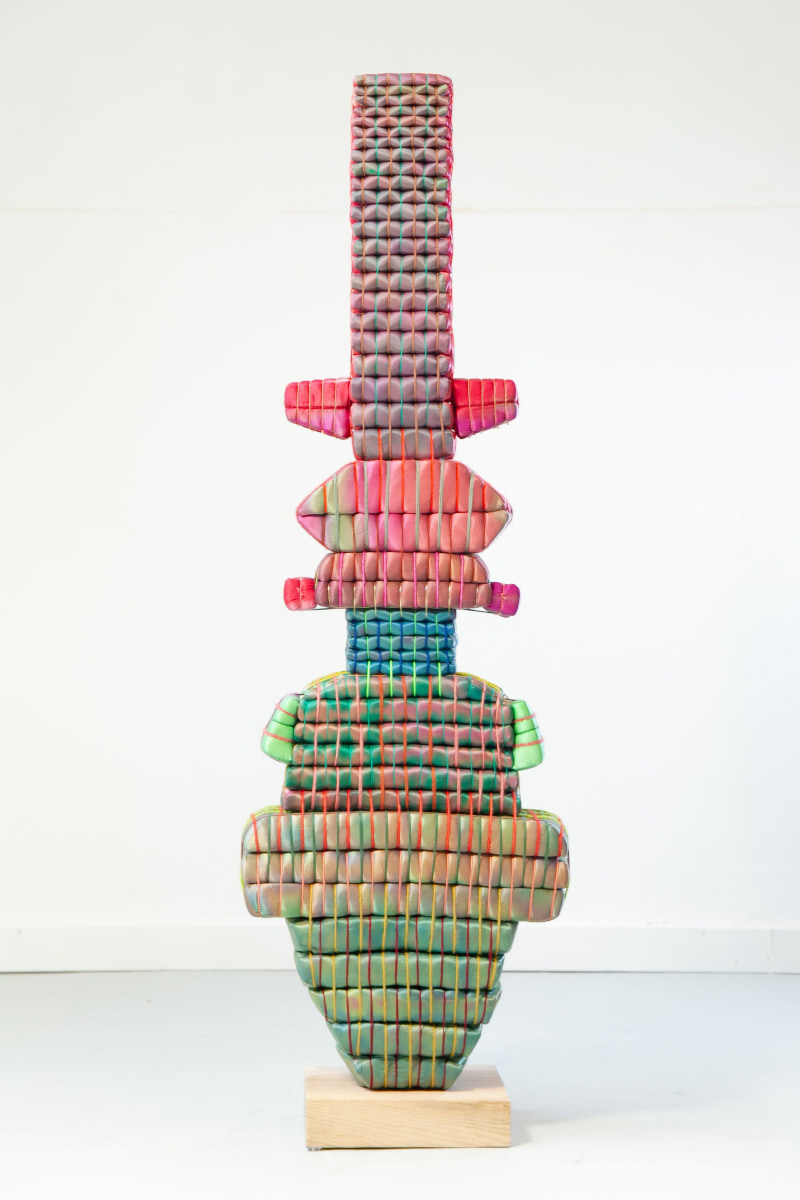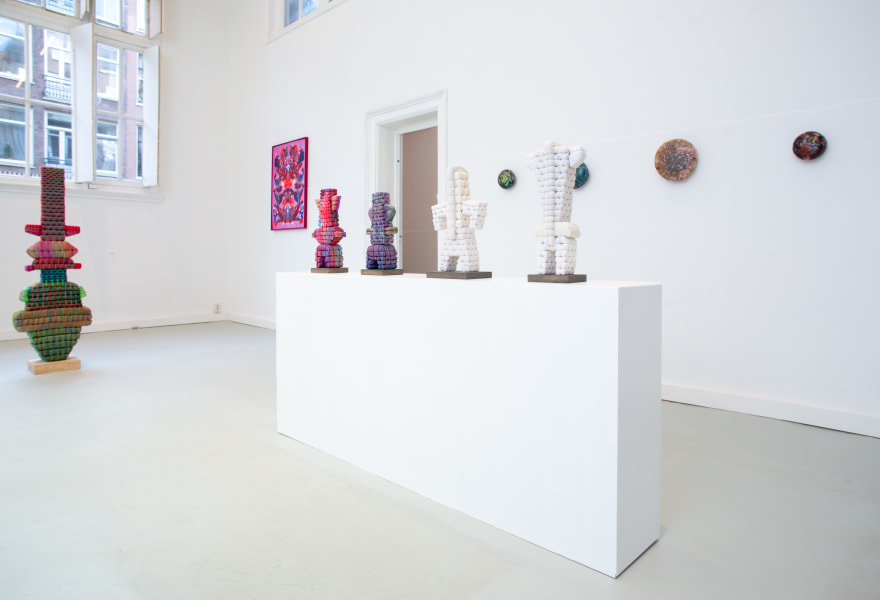13 january 2023, Wouter van den Eijkel
Three-dimensional weaving with fabric and foam - The joy of making is evident with Saar Scheerlings' talismans
“Oh, you look like this one!” Artist Saar Scheerlings regularly hears viewers telling each other this when encountering one of her talismans. The colourful sculptures of stacked and crocheted polyurethane foam instantly pull you into Saar Scheerlings' universe. A world that she compares to a port city: a place where cultures merge from which something new emerges.
“Children in particular like to touch them,” says Saar Scheerlings about the talismans, the sculptures she makes from stacked and crocheted foam rubber and finished with dyed silk. This is usually not part of the experience of viewing art, but with Scheerlings' soft sculptures it is difficult to resist the temptation. “They are figures who radiate something protective, as if they want to be adopted.”

Saar Scheerlings, Talisman Beatle, 2022, Galerie Fleur & Wouter
Unfolding is the first solo exhibition by Scheerlings (NL, 1990), who was trained at the Design Academy in Eindhoven and has a studio in Burgundy, France. There she has enough space to store the old mattresses, the basic material of the talismans. “Once you know what you want to do, you have to go all-in,” she says of the trip she made to Groningen to pick up a busload of discarded mattresses. Galerie Fleur and Wouter showed her work once before, at Art Rotterdam in 2021. At the time, it was only the talismans and work on paper. For Unfolding Scheerlings also works with ceramics and worked with glass for the first time.
Three-dimensional weaving
Scheerlings based the talisman sculptures loosely on a series of collages she made and on the 1888 painting Le talisman by Paul Sérusier that she saw at Musee d'Orsey. You will usually find talismans in museums in the ethnographic department, a term that Scheerlings finds somewhat misleading. She herself prefers to speak of folk art. “People immediately think of something exotic when they think of ethnography, but they forget that we also had a lot of folk art in the Netherlands, such as traditional costumes. I find the craft interesting.”
Scheerlings interest in crafts is evident from the way the talismans are made. Just as you can see the dovetail joints between the different parts of a wooden cabinet, you can see the knotted rope connections on the outside of Scheerlings' talismans. “A kind of three-dimensional weaving”, Scheerlings calls her working method; it is a labour-intensive and time-consuming process. For example, she worked for several weeks on the largest work in this knotting technique: a talisman in the shape of a totem pole on a base of ash wood.

Saar Scheerlings, Untitled (Talisman), 2023, Galerie Fleur & Wouter
The joy of making
What immediately stands out is the apparent pleasure with which they are made. This can partly be explained by Scheerlings' working method, which is quite intuitive. For her, the creative process determines the outcome. The different parts of the sculpture react to each other and this is how an image is created in an organic way. “At a certain point I will have a piece in this colour,” she says, pointing to a dark green body part of a talisman, “then I decide which shapes and colours go with it”.

Saar Scheerlings, Talisman Fluo, 2022, Galerie Fleur & Wouter
The results is hard to situate in any particular location. The talismans do not seem to come from the Netherlands or Western Europe, you rather situate them with the Aztecs or the Incas in Central and South America. That is not very surprising, because Scheerlings compares her practice time with a port city. “A place where all kinds of cultures meet and influence each other. And then new expressions arise that may grow into a complete culture. If someone hands me a case of silk paint, that suddenly also part of my practice.”
Versierd Gereedschap
Scheerlings' interest in crafts, however, goes beyond the techniques. The glass sculptures hanging on the wall are based on spindles. The way the produce yarn before the invention of the loom. These spinning tops were often decorated with cosmological representations. They were decorated tools, used day in and day out. Scheerlings' spinning tops also have such representations.

Saar Scheerlings, Cosmic Whorl IV, 2023, Galerie Fleur & Wouter
Of course, the spinning tops are hand-blown, but what Scheerlings also wants to do is to indicate the place crafts, in this case the production of cloth, once held in our society. “A few years ago, I was in India and in a village I visited the looms were integrated into the architecture. The beams of the balconies protruded and the looms were attached to them. This allowed the residents to weave in public and in the open air”. That's another way to do it.
Unfolding by Saar Scheerlings is on display at Galerie Fleur en Wouter in Amsterdam until 29 January
